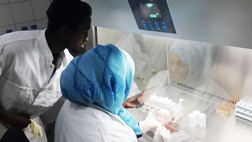 Laboratory technicians working on cholera culture at the Public Health Laboratory in Mogadishu, SomaliaThe World Health Organization (WHO) Country Office in Somalia has taken proactive steps to scale up the health emergency preparedness and response capacities in all regions of Somalia to better manage health consequence of El Niño conditions. In view of this, WHO is working closely with health authorities, United Nations agencies and other partners to implement the national contingency plan to minimize the impact of the El Niño climate phenomenon and respond to any potential health emergencies.
Laboratory technicians working on cholera culture at the Public Health Laboratory in Mogadishu, SomaliaThe World Health Organization (WHO) Country Office in Somalia has taken proactive steps to scale up the health emergency preparedness and response capacities in all regions of Somalia to better manage health consequence of El Niño conditions. In view of this, WHO is working closely with health authorities, United Nations agencies and other partners to implement the national contingency plan to minimize the impact of the El Niño climate phenomenon and respond to any potential health emergencies.
Assessment mission
The WHO pandemic and epidemic programme conducted a mission to assess the cholera preparedness and response capacity in the country and provide guidance to strengthen the coordination, disease surveillance and the overall cholera response activities between 27 January and 7 February 2016 in Mogadishu and Garowe in Somalia.
The mission highlighted WHO’s commitment to support the overall emergency preparedness and response effort to the health impact of El Niño climate phenomenon in Somalia. During the visit, WHO advocated the reinforcement of multisectoral cholera response interventions to prevent and contain cholera outbreaks, including:
- an efficient coordination mechanism through health cluster with the aim of harmonizing cholera response interventions implemented by cluster partners;
- enhancing disease surveillance for early detection and confirmation;
- proper case management to reduce case-fatality rate;
- providing access to clean water and proper sanitation;
- intensive social mobilization for hygiene promotion;
- and provision of adequate medical supplies.
However, Somali health authorities and humanitarian aid agencies need to do much more to prevent and control cholera in hotspot areas, mainly displaced camps and congested settlement in the main urban centres.
El Niño climate phenomenon
The ongoing El Niño climate phenomenon may exacerbate the risk of cholera and other waterborne diseases in Somalia, and trigger other major communicable disease epidemics. El Niño conditions have already increased seasonal rainfall in south-central regions with flooding from September to December 2015, while northern regions of the country are currently experiencing severe drought, with water and food scarcity which may lead to food insecurity, malnutrition and diseases. Somalia is already experiencing a protracted complex emergency in the last 25 years due to recurrent conflict, drought, floods and food insecurity. Thousands of Somalis are currently at risk of communicable disease epidemic, cholera and other waterborne diseases, in particular due to limited access to clean drinking-water, sanitation and hygiene, and proper health care services.
Somalia has experienced seasonal cholera outbreaks in recent years, and it is one of the most frequent disease outbreaks reported in Somalia for the past two decades. The worst cholera epidemic was recorded in 2012 with over 26 000 cases and 200 deaths while an average 7000 cholera cases were reported annually in the subsequent years. In 2015, cholera epidemics were confirmed in Kismayo, Baidoa, Jowhar and others locations along the two main rivers, and over 5200 cases and 84 deaths (case fatality rate of 1.6%) were reported. Over 65 percent of the cases and deaths were children under age 5. Although the overall trend has been decreasing in the first two months of 2016, over 500 cases and 15 deaths were recorded from different locations in South Central regions. Likewise, there are concerns that the current cholera outbreak could spread to other regions of the country as observed in the previous epidemic. Furthermore, unusually high rainfall and subsequent flooding have triggered major outbreaks of cholera in the neighboring countries including Ethiopia, Kenya, Uganda, Tanzania, South Sudan, Democratic Republic of Congo and others.


